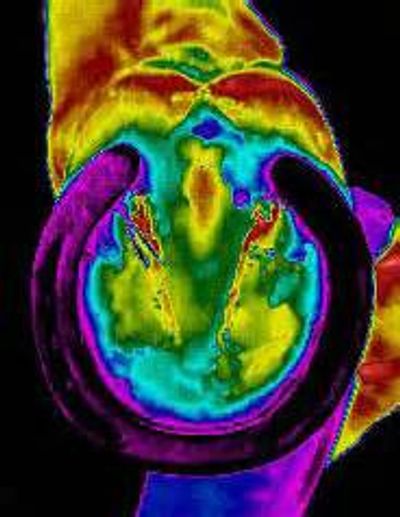Seeing Inside The Hoof Using Thermal Imaging

Locatng a Abscess Using Thermal Imaging
Our thermal imaging cameras are very sensitive and can accurately map the temperature patterns on your horse's hoof allowing the detection of abscess's.
Where there is an Abscess pus will be inside the foot, particularly where it is trying to come out the coronary band. Thermal imaging allows your Vet or Farrier to have pinpoint accuracy when draining. Follow-up imaging can show when the infection has fully cleared up.
What is a abscess?
An abscess is an extremely localized infection, which is generally "walled off" within the hoof capsule. There are numerous causes for such infections; however, the primary causes are fungal infections, puncture wounds, and seedy toe. Left unattended, an abscess will migrate up the hoof capsule, following the path of least resistance, until it eventually "blows out" through the hoof wall or, often, at the coronary band , when the abscess blows out the corornary band it is called a "quittor". In this image to the left is a "solar abscess". Clearly you can see where all the red (heat) is. The abscess completely wraps around the frog area.
Symptoms:
- lameness
- gait is off in one direction
- altered hoof landing pattern
- heat, strong digital pulse
- not wanting to put weight on foot
- concussion sensitivity
Prevention:
- provide clean and debris free environment
- ride on soft terrain
- shoes, boots
- clean feet daily
Treatment:
Abscesses can be opened and drained from the ground surface. They also can be drawn out from the cornory band with icthomal. Since opening an abscess is an invasive procedure and often involves contact with sensitive tissue, a qualified Farrier or veterinarian should be contracted to debride the infected area. You may need to administer appropriate medications and tetanus vaccines. Treatment I use is to provide a small drain hole which should be left open for extended drainage and application of medication's, poultices, and soaking twice a day for a half hour in warm water with Epson Salts. Do that for about one week period. Continue treatment with soaking and poultices/ medications until horse shows noticeable improvements in walking. Don't stall up the horse but if possible let stay in small paddock. The more the horse walks around the quicker the healing will be.
Thermal imaging can accurately locate an Abscess. Notice the heat in these thermal images below . Our thermal imaging cameras are very sensitive and can accurately map the temperature patterns on your horse's hoof allowing the detection of infected areas.
Hoof Imbalance Issues Revealed Using Thermal Imaging

Out Of Balance
Equine Hoof Balance and Foot Problems
Our silent running cameras are well tolerated by horses. As the saying goes, “no foot, no horse”. An incorrectly balanced foot can have extensive knock-on effects on the leg and back, and affect your horse's comfort and performance. Our thermal imaging cameras are very sensitive and can accurately map the temperature patterns on your horse's hoof allowing the detection of common foot problems including: Poor Circulation, Abscess, Laminitis, Injury and checking Hoof Balance.
Notice pic on left, the image shows the color black where the horse bares more weight versus the purple area of the shoe shows the horse bearing less weight. It should be symmetrical in weight displacement on the shoe and the color of the shoe on our image should be the same .
Horse Foot Problems
Look at these thermal images for out of balanced feet.
Image on left: As this foot grows out it continues to carry more weight on the inside of the foot. The image shows more intense heat on the inside.
Middle Image: You can see on the right side of the hoof just below the hairline a hot spot. Also if you look at the coronary band is jammed up, showing a hoof imbalance
Image on the right: the color black on the right side of the shoe is where the horse bares more weight, causing a imbalance. Within a few minutes of lounging the thermal image was taken.
How much does it cost to see if my horse is out of balance?
Circulation Issues Captured With Thermal Camera

Restricted blood Flow Seen Through Thermal Imaging
Horse on the left has heel pain and the foot on the right has bruising. Explains why both horse's where not performing to their best. Change in shoeing helped this horse by giving him more heel support. A year later this horse was diagnosed with Navicular.
Poor circulation in the feet will affect the quality of the hoof wall. Many people decide to go with the traditional hot or cold shoeing practice. Glue on rubber or plastic shoes have been gaining traction lately to help bring more circulation to the hoof. The rubber shoes flex more than a metal shoe thereby allowing the hoof to open/ close and promote better circulation through proper frog contact with the ground. I prefer horses to go barefoot, if their continues to be a problem with poor circulation, then their could be nerve damage done. A Vet consultation will help you with your options of treatment going forward.
How much does it cost to see if my horse has circulation problems?
Prepare Your Horse For The Thermographer
